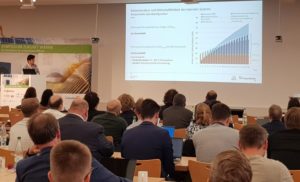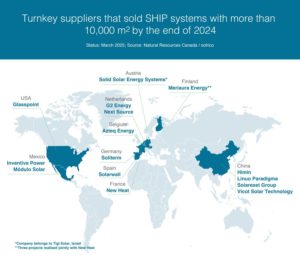Germany: Solar Process Heat Cheaper than Fossil-Fuel Heat, but Outperformed by CHP
December 4, 2013
Solar thermal process heat is economically viable in many cases in Germany if it replaces heat from gas or oil boilers, thanks to a 50 % subsidy by the German Federal Office of Economics and Export Control, BAFA. But solar process heat cannot compete with combined heat and power (CHP) plants, because the electricity production saves the user so much money that the heat is almost for free. This is one of the key findings of a study commissioned by the German solar industry association BSW Solar and carried out by German engineering and consulting firm Fichtner and the German Institute decentralised Energy Technologies (IdE). The study, which is not published yet, was presented at the conference Forum Solarpraxis in Berlin, Germany, in November.
The study is based on a solar thermal plant with different aperture areas and at various operation temperatures that, in summer, provides all the base load for a continuous process and needs no storage tank. To guarantee complete availability of the heat all year round, the conventional boiler or CHP system cannot have a smaller size. This means that the solar plant has to compete directly with the fuel costs of fossil-fuel heat generation, excluding investment. Table 1 shows a comparison of the total costs for solar process heat (300 m2 aperture area, 60 °C operation temperature), with variable costs for supply based on fossil fuels. Heat prices from the flat plate and vacuum tube collector field are lower than the variable costs of the boiler versions. At an operation temperature of 80°C, only vacuum tubes are competitive with gas and oil boilers.
| Total costs for solar process heat from flat plate collectors, including 50 % subsidy | 6.46 | ct/kWh |
| Total costs for solar process heat from vacuum tube collectors, including 50 % subsidy | 5.37 | ct/kWh |
| Variable costs for heat from low-temperature gas boiler | 6.63 | ct/kWh |
| Variable costs for heat from low-temperature oil boiler | 9.07 | ct/kWh |
Heat prices of solar process heat at 60°C, including 50% investment, trump variable costs of heat supply by fossil-fuel boilers (in Euro cents = ct). Investment capital was based on a bank loan at current conditions.
Source: Fichtner / BSW Solar
The downside of solar process heat is that it cannot compete with cogeneration plants whenever electricity is needed as well. The main reason is that users of CHP save a lot of money on electricity, so that CHP heat is regarded as an almost free by product. That grid electricity is subject to high surcharges and taxes, but electricity produced by the CHP plant itself is not, can be seen as “indirect subsidies”. The taxes and surcharges for grid electricity include 2.05 ct/kWh of electricity tax, 5.28 ct/kWh for feed-in tariff surcharges on renewable energies and up to 0.13 ct/kWh for levies to support CHP plants. To lower these charges and encourage CHP, there is no energy tax on fuel used in CHP plants, reducing operating costs of a CHP plant by 4.53 ct/kWh of the needed gas. According to Fichtner’s calculations, this leads to a heat price of 0.28 ct/kWh for a gas-fired CHP plant (see Table 2). Table 2 shows that heat costs increase up to 7.31 ct/kWh for CHP plants when removing the different tax reduction schemes.
These calculations have led BSW Solar to conclude that the “indirect incentives” for CHP create an economic handicap for solar thermal process heat. Less tax reductions on fuel and taxing electricity produced by the CHP plant itself would lead to higher costs for heat from a CHP plant, and would make solar thermal more competitive. BSW Solar is working on a position paper to call for a “fairer incentive policy” towards CHP and solar thermal.
| Variable heat costs from CHP plants in different tax reduction scenarios regarding electricity | |
| Based on current legislation | 0.28 ct/kWh |
| Without fuel tax benefit | 1.42 ct/kWh |
| Without fuel tax benefit, CHP-produced electricity taxed | 2.44 ct/kWh |
| Without fuel tax benefit, CHP-produced electricity taxed and feed-in tariff levies on all of it | 5.92 ct/kWh |
| Without fuel tax benefit, own electricity taxed and feed-in tariff, as well as CHP support levies on all of it | 7.31 ct/kWh |
Table 2: Comparison of variable heat costs from CHP at different taxation levels
Source: Fichtner / BSW Solar
If the current conditions persist, solar process heat will not be able to compete with CHP until 2030, assuming an annual increase in gas prices of 5 %, the authors of the Fichtner study say in the last chapter “Outlook 2020 and 2030”. To be competitive with CHP by 2020, solar thermal system costs will have to be reduced by 80 %. To compete with gas boilers by 2020, system costs will have to decrease by 15 %. In comparison to oil boilers, solar thermal process heat will be economically viable by 2016 without subsidies, simply based on rising fuel costs.
The situation has been a problem for solar thermal process heat for several years. “We would not even have had a chance to win that tender, even if we had set up the entire solar plant for free,” Detlev Seidler, Managing Director of Ritter XL Solar, says about a project for a concrete factory in an article published in SONNE WIND & WÄRME in summer 2011.
Solving this issue will not be easy. Germany needs to create flexible electricity generation capacities to complement variable and intermittent renewables, such as wind and solar. Also, taxation of electricity produced by the CHP plant itself would be a legal challenge. The CHP support in Denmark might be a model: Gas prices in the country are higher in general, and electricity from CHP is sold at market prices. This leads to economically feasible CHP in winter, but to non-viable conditions in summer, making room for solar thermal.
BSW Solar: http://www.solarwirtschaft.de (only in German)
Fichtner: http://www.fichtner.de
ide: www.ide–kassel.de/


